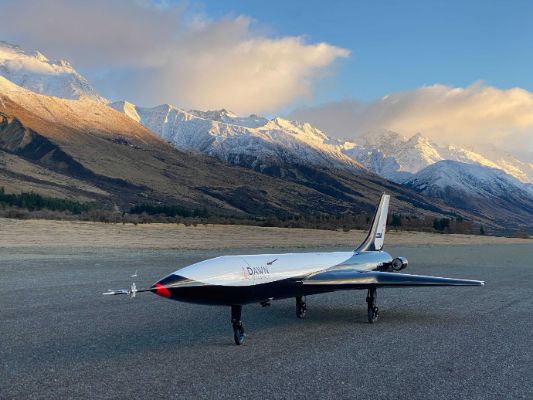Dawn Aerospace Spaceplane Ready For Rocket Powered Flight After Completing 48 Flights Using Jet Engines

Dawn Aerospace has completed 48 flights over last 13 months of their spaceplane technology demonstrator, The Mk-II Aurora, to complete Phase One testing of the vehicle using surrogate jet engines. Tests of the vehicle under rocket power are expected before the end of the year.
Phase One demonstrated all non-rocket systems on the spaceplane such as low speed aerodynamic performance, pilot controllability, reliability and general airworthiness. The spaceplane was flown as fast as 200 knots (370 km/h) and 9000ft altitude, although high speed and altitude were not primary goals.
“This test phase has shown that the basic design is extremely capable, but above all, safe. It was also a key step to show that the team is ready to take on the challenge of rocket-powered flight,” CFO and Mk-II Chief Engineer James Powell says.
In Phase two of the test program the Mk-II Aurora will be fitted with a rocket motor which will allow for flights to over 100km altitude and 3500km/h. If achieved, it would be the first vehicle to ever to reach space twice in a day – “a Wright Brothers moment for reusable spaceflight” says Stefan Powell, CEO.
The Mk-II is intended to prove the core technology needed for a fully and rapidly reusable first stage booster.
Once the Mk-II Aurora is proven under rocket power, a much larger Mk-III vehicle will be built, with the capability to deliver a 250kg satellite into orbit using a second stage released at high altitude.
“Rapid reusability is the key to cost effective spaceflight” said Stefan Powell, “Operating under aviation law, and with a vehicle that is an aircraft first, and a rocket second, allows us to unlock the powers of fleet economics. We can replace an entire rocket factory with a few aircraft that operate daily”.
Phase One test flights were conducted under aircraft certification, specifically Civil Aviation Authority Part 102. As of September, all test goals were achieved, including a “pseudo-rocket powered flight” where the aircraft was flown at full thrust and a high pitch angle to moderate altitude before having the engines intentionally set to idle, mimicking main engine cut-off. Thereafter, the aircraft was brought into land using only manoeuvres and air brakes to control airspeed, similar to what will be done after re-entry from high altitude.
Glide landings were repeated several times as part of the team’s final flight training before the spaceplane will be fitted with a rocket motor. In addition to substantial simulator testing, these tested served as confirmation that the team is ready for rocket powered flight
“As a clean sheet design, there were naturally many aspects that were unproven. The combination of simulation and real testing is critical in achieving a safe and successful campaign.” said CFO and Mk-II Chief Engineer James Powell.
Phase one also demonstrated key operational aspects of the spaceplane, including rapid reusability, up to four flights in a day, and flights under aviation law.
“We are on the path to revolutionising how we access space. The ability to rapidly reuse a launch vehicle reduces costs by 90 per cent, hence it has always been the holy grail of affordable, frequent space flight” says James Powell.
The Mk-II rocket engine is a liquid propellant rocket motor, developed by Dawn Aerospace. It uses the non-cryogenic fuels hydrogen peroxide and kerosene which aircraft storable, unlike typical rocket fuels like liquid oxygen. The engine, which is in the final stages of qualification, is designed for rapid restarts without the replacement of igniters or other maintenance.
Test flights of the Mk-II under rocket power are anticipated before the end of the year.



 Fix & Fogg: NASA Hand-picks Kiwi Nut Butter Brand To Travel To Space In NZ First
Fix & Fogg: NASA Hand-picks Kiwi Nut Butter Brand To Travel To Space In NZ First Citizens of the Sea: Sailors To Revolutionise Our Understanding Of Pacific Biodiversity
Citizens of the Sea: Sailors To Revolutionise Our Understanding Of Pacific Biodiversity Netsafe: Making A Splash With Online Safety: Netsafe Launches New Flagship Programme For Kids
Netsafe: Making A Splash With Online Safety: Netsafe Launches New Flagship Programme For Kids NZGBC: Flood Resilience PhD Student Widi Auliagisni Named Future Thinker Of The Year 2024
NZGBC: Flood Resilience PhD Student Widi Auliagisni Named Future Thinker Of The Year 2024 Business Canterbury: European Free Trade Agreement A Game-changer For Canterbury
Business Canterbury: European Free Trade Agreement A Game-changer For Canterbury Business Canterbury: Urges Council To Cut Costs, Not Ambition For City
Business Canterbury: Urges Council To Cut Costs, Not Ambition For City



